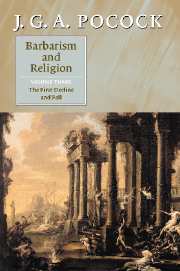Book contents
- Frontmatter
- Contents
- Acknowledgements
- Note on usages
- List of abbreviations
- Introduction
- PROLOGUE
- 1 Gibbon's first volume: the problem of the Antonine moment
- PART I THE FIRST DECLINE AND FALL: ANCIENT PERCEPTIONS
- PART II THE AMBIVALENCE AND SURVIVAL OF CHRISTIAN EMPIRE
- PART III THE HUMANIST CONSTRUCTION OF DECLINE AND FALL
- PART IV EXTENSIVE MONARCHY AND ROMAN HISTORY
- PART V REPUBLIC AND EMPIRE: THE ENLIGHTENED NARRATIVE
- PART VI GIBBON AND THE STRUCTURE OF DECLINE
- EPILOGUE
- Bibliography of works cited
- Index
1 - Gibbon's first volume: the problem of the Antonine moment
Published online by Cambridge University Press: 15 December 2009
- Frontmatter
- Contents
- Acknowledgements
- Note on usages
- List of abbreviations
- Introduction
- PROLOGUE
- 1 Gibbon's first volume: the problem of the Antonine moment
- PART I THE FIRST DECLINE AND FALL: ANCIENT PERCEPTIONS
- PART II THE AMBIVALENCE AND SURVIVAL OF CHRISTIAN EMPIRE
- PART III THE HUMANIST CONSTRUCTION OF DECLINE AND FALL
- PART IV EXTENSIVE MONARCHY AND ROMAN HISTORY
- PART V REPUBLIC AND EMPIRE: THE ENLIGHTENED NARRATIVE
- PART VI GIBBON AND THE STRUCTURE OF DECLINE
- EPILOGUE
- Bibliography of works cited
- Index
Summary
Gibbon published the first volume of The History of the Decline and Fall of the Roman Empire on 17 February 1776. He was in his thirty-ninth year and, once his father's death in 1770 had left him in a condition of independence, had moved to London and taken a house in Bentinck Street in search of what he termed ‘study and society’. The paired terms indicate that the Decline and Fall was to be a work of Enlightenment, in the primary sense that the life of the mind was to be, freely but inescapably, a life in society. Though Gibbon liked to be considered a virtuoso – ‘a gentleman who wrote for his amusement’ – he knew very well that he was pursuing a vocation; from infancy, he believed, he had been formed to be a historian. This vocation, however, was not to be a profession, in either the clerical-academic or the nineteenth-century sense of that word; Gibbon pursued it in the company of urban and urbane gentry, gentlemen of letters in a sense differing from the French gens de lettres. He was a member of the Literary Club, formed by Joshua Reynolds with the intent of elevating painting – as David Garrick sought to elevate acting – from a trade to a high art conducted in high society.
- Type
- Chapter
- Information
- Barbarism and Religion , pp. 7 - 14Publisher: Cambridge University PressPrint publication year: 2003



